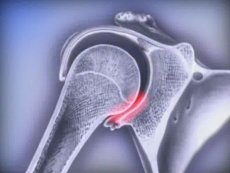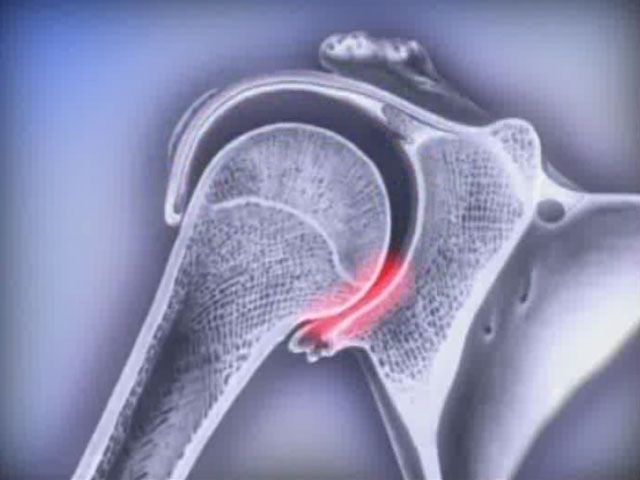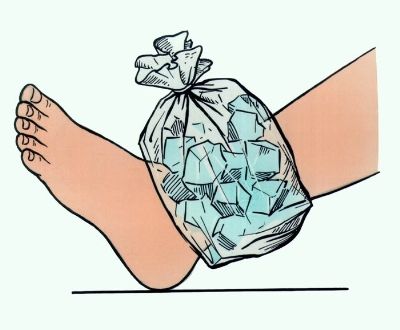Medical expert of the article
New publications
Pain in dislocated limbs
Last reviewed: 04.07.2025

All iLive content is medically reviewed or fact checked to ensure as much factual accuracy as possible.
We have strict sourcing guidelines and only link to reputable media sites, academic research institutions and, whenever possible, medically peer reviewed studies. Note that the numbers in parentheses ([1], [2], etc.) are clickable links to these studies.
If you feel that any of our content is inaccurate, out-of-date, or otherwise questionable, please select it and press Ctrl + Enter.

The pain of a dislocation can be so severe that a person loses consciousness. When a dislocation occurs, the position of the bones changes so that they take an unnatural position. This happens due to trauma. How can you tell if a person has a dislocated limb and what first aid should you give them?

What is a dislocation?
This is a joint injury, during which the normal position of the bones that form it is deformed, and the person becomes very painful. Most often, this situation occurs when a person falls on a straight arm. Then there is a sharp pain, and this is the main symptom by which you need to suspect a dislocation.
What causes this pain? Due to damage and injury to the tissues that surround the joint. First of all, these are nerve endings that transmit pain impulses to the brain, as well as ligaments, muscles and blood vessels. When a joint is injured, its shape changes dramatically. It can become sunken or, conversely, a pit forms on it. Movements are severely limited due to pain, it is impossible to even move the sore arm or leg.
The nature of pain in case of joint dislocation
The pain from a dislocation is constant. It can be twitching, aching, dull, but it is always constant and never-ending. As soon as a person makes the slightest movement, the pain becomes even stronger. It becomes a little easier only if you do not move at all.
First aid for dislocation
As soon as a person discovers such symptoms after an injury or blow, he or she should immediately call an ambulance. First of all, an X-ray of the damaged joint should be taken. From the X-ray, the doctor will definitely see whether it is really a dislocation, what the nature of this dislocation is, and whether the bones are intact (maybe there is a crack in them).
After this, the dislocation is reduced (this is also quite painful, but the pain is short-lived). To avoid this pain, the person is given general or local anesthesia. The affected limb or body part is fixed with a fairly tight bandage or a plaster cast is applied so that the joint does not move out of the correct position. Then - another repeat x-ray to make sure that everything is okay with the patient.
 [ 3 ]
[ 3 ]
Medicines for dislocation
Treatment for dislocation is prescribed by a traumatologist. He most often prescribes drugs such as nimesulide, xefocam, diclofenac, indomethacin, meloxicam and others. These are drugs that do not contain steroids and that relieve inflammation, pain, swelling, and also fight possible infections.
It is very important to tell the doctor about your illnesses before he prescribes medications. The fact is that with some diseases of the gastrointestinal tract, such as gastritis, stomach ulcer or duodenal ulcer, some drugs can cause harm. Ointments and balms with anti-inflammatory properties are also used. Ointments with troxevasin in the composition help to cope with bruises and swelling at the site of injury, relieve swelling.
Physiotherapy
In order for the pain to subside faster and the affected joint to heal more actively, the doctor recommends physiotherapy. But this is already a few days after the joint has been set and can be disturbed. These are special exercises for the limbs and the whole body, as a result of which incomplete, painfully difficult movements are restored, injured muscles, ligaments and tendons heal faster.
In addition to physical education (therapeutic physical education - LFK), massage and physiotherapy are also prescribed. If you follow all the doctor's instructions correctly, then in a month there will be no trace of the dislocation.
What types of dislocations are there?
The violation of the integrity of the joints, which is accompanied by the displacement of the ends of the bones, can be different. Two large groups of dislocations are acquired and congenital. Acquired dislocations are distinguished as pathological and traumatic. Traumatic, in turn, are divided into habitual and unusual.
As for the degree of joint integrity violation, dislocations can be complete (joints can no longer touch each other as a result of injury) and incomplete. Doctors also call incomplete dislocations subluxations. With these joint injuries, the bones are displaced, but still partially touch each other.
Dislocations can also be open and closed. Those in which the skin is damaged in the area of the joint, that is, a person sees a wound on the skin - open dislocations. If the skin in the area of the damaged joint remains intact - these are closed dislocations.
A dislocated bone is not just an injured bone, but one that changes its position and moves beyond the contours of the body. If the shoulder joint is dislocated, it is called a dislocated shoulder, and if the hip joint is dislocated, it is called a hip or pelvis dislocation.
What is congenital dislocation?
Congenital dislocation is a dislocation that is detected in a child at birth - this is logically clear. The most common dislocation is usually a dislocation of the hip joint, and it occurs most often in girls. Among congenital hip dislocations, there are unilateral or bilateral ones.
It is very difficult for a mother to understand that her newborn baby has a hip dislocation - only a doctor can determine this. That is why after the birth of the child, several doctors of different specialties examine him at once, including a traumatologist. The doctor examines the difference between the location of the baby's skin folds, as well as the outward rotation of the leg. Sometimes one leg of the child may be shorter than the other. This is a consequence of congenital dislocation.
When to start treating congenital dislocation?
If you take care of the child's joints in the first months after birth, they can be set without surgery. If you do not detect a dislocation in time and delay the treatment process, a congenital dislocation can leave indelible consequences in the form of deformation of a limb or the entire body.
You can see a dislocation very well when a child, taking his first steps, begins to limp, cannot step on the sore leg. This is with a unilateral dislocation. But if the dislocation is bilateral, then the child's gait is not like that of healthy children - even, with uniform movements, but like a duck's gait, waddling from foot to foot.
Up to two years, a congenital joint dislocation – unilateral or bilateral – can still be corrected. But if the child is over two years old, only surgery can save the situation and straighten the joint.
Obvious symptoms of congenital dislocation are detected when the child begins to walk (limping, shortening of the limb on the side of the dislocation). With bilateral dislocation, the gait is waddling, reminiscent of a duck.
If congenital hip dislocation is detected after the age of 2 years, reduction is usually only possible by surgery.
How does a traumatic dislocation occur?
This most often occurs due to movement of the joint that is not typical for it, as well as strong pressure or load on the joint. With a traumatic dislocation, ligaments and joints are usually damaged (except for jaw dislocations). If it is an elbow injury with a dislocation, nerve roots and blood joints can be compressed.
Traumatic dislocation (especially in the elbow joint) can be accompanied by compression and even rupture of blood vessels or nerves. This causes sharp and severe pain, limitation of movement not only of the damaged joint, but of the whole body - pain causes the slightest movement. Also, traumatic dislocation of the joint can be accompanied by deformation of the joint.
What is the difference between a dislocation and a bruise?
The fact that with a bruise, pain and limited movement arise gradually, not immediately, the pain increases. But with a traumatic injury to a joint, pain arises immediately and sharply, and limited mobility of the joint too.
How are traumatic dislocations treated?
They are adjusted by setting the joints in the correct position. In this case, anesthesia may be used - local or general, to reduce severe pain. Then the joint is fixed with plaster or a special bandage so that it takes the correct shape and remains stable in it. In this case, it takes time for the damaged ligaments and joints to heal.
If the dislocation is fresh and little time has passed since then, it can be reduced much faster and manually, without special devices. Of course, an amateur cannot do this, moreover, such attempts are harmful to health.
Ligaments and tendons can be torn during such attempts, and ligaments are much more painful and take longer to treat than a joint. To reduce a traumatic (or any other) dislocation, you need a person with special knowledge and extensive practice. Ideally, this is a traumatologist.
The sooner a person is taken to the emergency room after a dislocation, the faster and more effectively it can be treated. If the dislocation is not reduced and tolerated for more than two weeks, the soft tissues of the joint begin to scar on their own, and then reduction without surgery is no longer possible.
A traumatic dislocation with an open wound in the area of the affected joint requires special knowledge and the fastest possible medical care. A person whose blood vessels are damaged during a dislocation should be taken to the emergency room as quickly as possible. If help is not provided in time, internal bleeding and blood infection are possible.
What are the most common dislocations?
The most common traumatic dislocations are the areas of the fingers and toes, lower jaw, hip, forearm, shoulder. For example, shoulder dislocation is 50% of all dislocations that patients receive.
Shoulder dislocation
When the shoulder joints are injured and come out of their usual position, a sharp pain in the shoulder occurs. Not a single movement of the shoulder can be made - it is immediately pierced by severe pain. Its shape immediately changes.
The shoulder, compared to its position in a healthy state, seems to be lengthened, it is behind the torso area, goes beyond its outlines. The patient's posture also changes. The person leans more towards the side where the shoulder is injured - this makes it easier for him to endure severe pain. The patient immediately grabs the injured arm, mainly the forearm or elbow.
How to help?
You need to hang the sore leg with a scarf and immediately go to the emergency room.
Forearm dislocation
A forearm dislocation is the "honorable" second place after a shoulder dislocation. It can be recognized by severe pain in the elbow area, sometimes the pain radiates to the fingers of the injured hand. The forearm is indifferent to any movements, they cannot be made due to pain. It hangs like a whip, a person grabs it to somehow support it. The elbow not only changes its shape, but also its color - it turns red, swells, and becomes edematous. True, redness does not always occur, but swelling is a must.
If a traumatic dislocation of the forearm is accompanied by compression of the vessels at the elbow, the hand and fingers of the injured hand turn blue or pale.
Children under 6-7 years of age should be very careful about traumatic dislocations of the shoulder and forearm, because they can happen very easily. If a child is jerked sharply by the arm, dressed or undressed carelessly and roughly, the baby's unstable joints can be damaged and move out of their usual position.
Help with a dislocated forearm
You need to secure the sore arm with a kerchief or scarf, hang it up, and call a doctor immediately.
Dislocation of fingers
With this traumatic dislocation, there is a sharp pain in the fingers, their position is deformed, it is unnatural, the finger begins to roughly protrude from the joint. Moving it at this moment seems unreal - the finger responds with a sharp, screaming pain. Of all the dislocations of the fingers of the hand, the most common is the dislocation of the thumb of the right hand.
First aid
If a person has an open dislocation of a finger, first of all, it is necessary to apply an antimicrobial bandage, and then call an ambulance. And in case of a closed dislocation (when there is no wound on the finger in the area of the damaged joint), you can immediately call a doctor. If it is not possible to call a doctor for a long time (for example, in conditions where there is no emergency room nearby), the damaged hand should be suspended on a sling or scarf. And before that, without changing the position of the deformed finger, you need to fix the hand with a thick layer of cotton wool and a bandage. The bandage should not be tight, so as not to damage the joint even more during jolts.
Hip dislocation
It is not so easy to damage it. To dislocate the hip, you need a very big gift or fall. When a hip joint dislocation occurs, severe pain in the pelvic joint area comes with it. Movement is limited, it is impossible to even move the injured leg, not to mention that it is also impossible to walk.
The most characteristic external sign of hip dislocation is that the knee of such a leg turns inward, towards the uninjured leg. It is extremely rare for the knee of the injured leg to turn outward – then the dislocated hip is moved away from the healthy one.
The best position for such a patient is lying on his back or on his side (opposite to the one that is injured).
Peculiarities of the body's reaction to dislocations

When a person has a dislocation of any part of the body (shoulder, wrist, hip joint), he may have accompanying symptoms. In another part of the body, a fracture, bruise, or sprain may occur with the injury, so this condition may be accompanied not only by pain in one part of the body, but also by bleeding, headache, and even loss of consciousness. Blood may come from the nose and ears, a person may vomit, feel sick, feel general weakness, and break out in a cold sweat.
The person should be laid on the healthy side of the body until the ambulance arrives. Cold can be applied to the injured area - dry ice or snow, you can make a compress with cold water to reduce pain and inflammation. You can also apply cold to the head, fix the injured limb with a bandage and wait for the doctor.
If you go to the hospital in a timely manner, a person will recover from a dislocation quite quickly.

